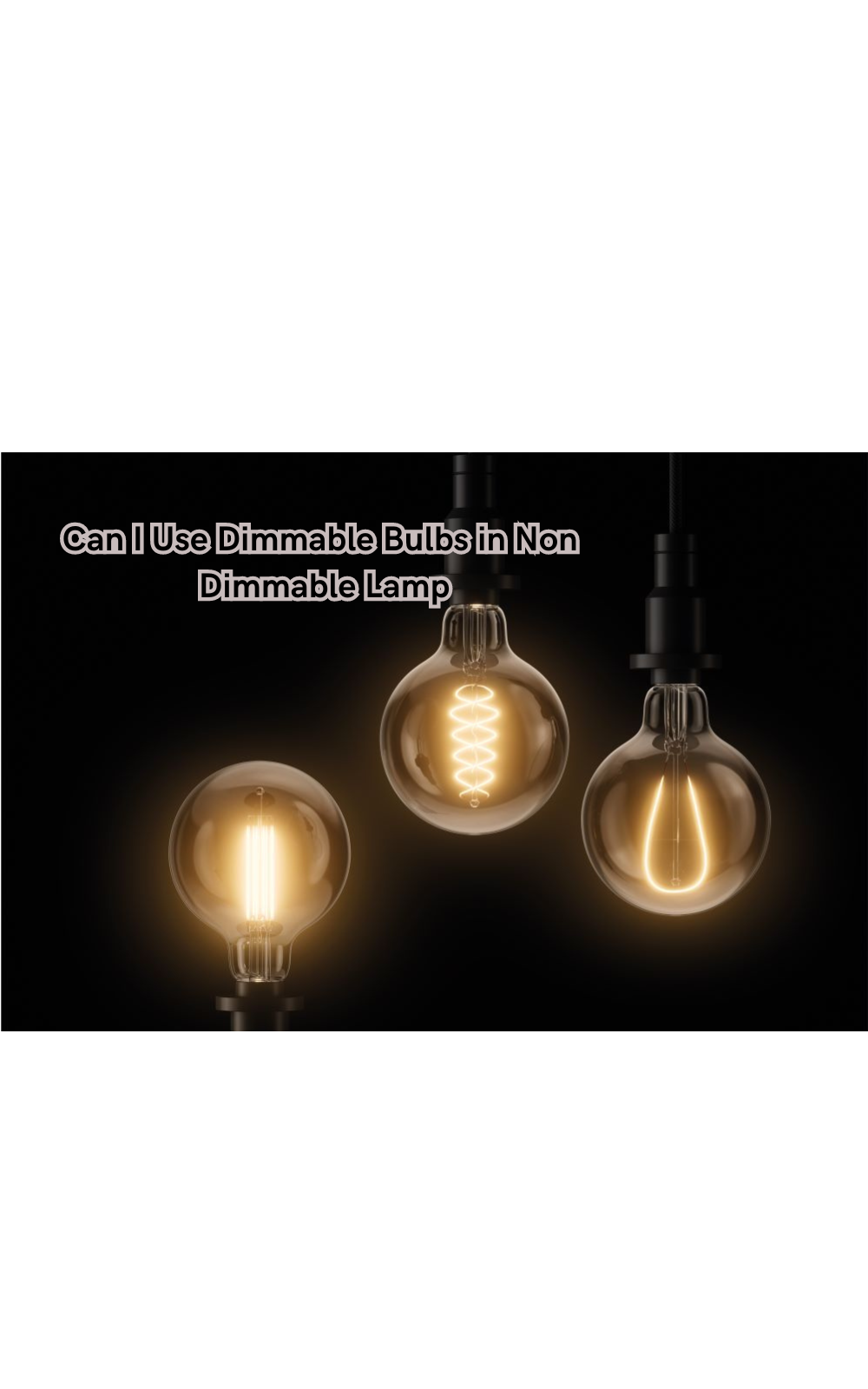Can I Use Dimmable Bulbs in Non Dimmable Lamp
Let's explore this practice's considerations, benefits, and potential drawbacks to help you decide whether to illuminate your non-dimmable lamp with dimmable bulbs.

Curious about using dimmable bulbs in a non-dimmable lamp?
This common query delves into the compatibility of dimmable LED bulbs with traditional non-dimmable fixtures. While it may seem straightforward, the implications of this choice extend beyond mere functionality.
Understanding the nuances of dimmable bulb usage in non-dimmable lamps can impact the bulb's performance and the overall lighting quality in your space.
Let's explore this practice's considerations, benefits, and potential drawbacks to help you decide whether to illuminate your non-dimmable lamp with dimmable bulbs.
What Are Dimmable Bulbs?
Before diving into the specifics, let's define dimmable bulbs.
As the name suggests, these bulbs can adjust their brightness level based on the electricity they receive. This functionality is typically achieved through a dimmer switch or a wireless control system.
Dimmable bulbs come in various types, such as incandescent, halogen, CFL (compact fluorescent), and, most commonly nowadays, LED (light-emitting diode). Incandescent light bulbs were the standard for dimmable lighting, but with technological advancements, LEDs have become the go-to choice due to their energy efficiency and longevity. Halogen light bulbs are also a popular choice for dimmable lighting, but they consume more energy and have a shorter lifespan than LEDs.
What Are Non-Dimmable Lamps?
Non-dimmable lamps, on the other hand, are light fixtures that cannot adjust brightness levels. These lamps are designed and wired to work with standard on/off switches, meaning they can only produce full or no light output.
Most traditional lamps, including table lamps, floor lamps, chandeliers, and wall sconces, fall under this category. However, some modern fixtures have built-in dimming capabilities through touch controls or remote systems. These may be labelled as "dimmable," but we will specifically focus on non-dimmable lamps in this discussion.
Can I Use Dimmable Bulbs in Non-Dimmable Lamps?
The short answer is yes, you can technically use dimmable bulbs in non-dimmable lamps. However, it's not always recommended or efficient to do so. Here are some factors to consider before making this choice:
Compatibility:
Not all dimmable bulbs are compatible with non-dimmable lamps. For instance, most LED bulbs require a specific type of dimmer switch to function properly, and using them with a standard on/off switch may result in flickering or buzzing.
Performance:
Dimmable bulbs may not perform optimally when used in non-dimmable fixtures. They may not reach their full brightness potential or have a limited dimming range, which defeats the purpose of having dimmable lighting in the first place.
Safety:
Using dimmable bulbs in non-dimmable lamps can also pose safety hazards. The increased heat generated by the bulbs may damage the lamp or even start a fire. Additionally, mixing and matching different types of bulbs in a single fixture can create an electrical imbalance that could be dangerous.
If you decide to use dimmable bulbs in non-dimmable lamps, read the product specifications and consult a licensed electrician for proper installation and compatibility checks.
Benefits of Using Dimmable Bulbs in Non-Dimmable Lamps
While there are potential drawbacks to using dimmable bulbs in non-dimmable fixtures, there are also some benefits worth considering:
- Energy Savings: Despite their higher upfront cost, LED dimmable bulbs can help save energy and lower your electricity bill over time. Adjusting the brightness levels allows you to use only the necessary amount of light and avoid unnecessary energy consumption.
- Flexibility: Dimmable bulbs offer flexibility in lighting options. You can adjust the brightness level based on your needs, mood, or time of day. For example, dimming the lights in the evening creates a cozy atmosphere for relaxation, and using brighter settings during work hours can improve productivity.
- Light Quality: Dimmable bulbs give you more control over the quality of light produced. You can create different ambiances by dimming or brightening specific areas of a room according to your preferences.
Can You Use Dimmable LED Light Bulbs without a Dimmer Switch?
The answer is no. As mentioned earlier, dimmable LED bulbs require a specific dimmer switch to function correctly. Attempting to use them with a standard on/off switch may result in malfunctioning or potential safety hazards. If you want the benefits of dimmable lighting, it's best to invest in a compatible dimmer switch or opt for lamps with built-in dimming capabilities.
Moreover, dimmable LED bulbs also have a higher price than non-dimmable ones. If you are not planning to use their dimming feature, sticking with non-dimmable LEDs may be more cost-effective. Dimmable LED light bulb prices have been dropping in recent years, so it's worth researching and comparing prices to determine which option is more budget-friendly for your specific needs. Dimmable LED bulb prices have been dropping in recent years, so it's worth researching and comparing prices to determine which option is more budget-friendly for your specific needs.
Tips for Choosing the Right Dimmable Bulbs
If you have decided to use dimmable bulbs in your non-dimmable lamp, here are some tips to help you choose the right ones:
- Look for LED dimmable bulbs with a high CRI (Color Rendering Index) of 90 or above. This indicates that the bulb can produce accurate and vibrant colors.
- Check the compatibility information on both the bulb and the lamp before purchasing. Compatibility issues can cause flickering, buzzing, or even damage to your electrical system.
- Choose a dimmer switch specifically designed for LED bulbs with adjustable settings to avoid any performance issues.
Dimmable light bulb technology has come a long way, and it's continuously evolving. With the right research and proper installation, you can enjoy customizable lighting in your non-dimmable lamps without compromising safety or efficiency.
How to Install a Dimmer Switch for Non-Dimmable Lamps
If you have decided to upgrade your non-dimmable lamps with dimmable bulbs, here are the general steps for installing a dimmer switch:
- Turn off power: Make sure to turn off the power supply at the circuit breaker before starting any electrical work.
- Remove old switch: Unscrew and remove the old on/off switch from the wall.
- Connect wires: Follow the manufacturer's instructions to connect the wires from your new dimmer switch to the correct corresponding wires in your wiring box.
- Mount dimmer switch: Carefully mount and secure the dimmer switch onto your wall using screws provided.
- Restore power: Turn the power back on at the circuit breaker and test the switch to make sure it is functioning correctly.
- Install dimmable bulbs: Once the dimmer switch is installed, you can now replace your non-dimmable bulbs with compatible dimmable LED ones.
Non dimmable LED bulbs have a wide range of benefits and can significantly enhance your lighting experience. However, it's essential to consider compatibility and safety factors before using dimmable bulbs in non-dimmable lamps.
FAQs
Can you use a dimmable bulb in a regular fixture?
No, it is not recommended to use dimmable bulbs in regular fixtures. The risk of safety hazards and potential damage to the fixture outweighs any benefits. Dimmable LED lamps are designed specifically to work with dimmer switches and should only be used in compatible fixtures.
Can you use a non-dimmable bulb with a dimmer switch?
Yes, you can use a non-dimmable bulb with a dimmer switch. However, the bulb will only function as a regular on/off light and will not be able to adjust its brightness level.
What happens if you put a non-dimmable light bulb in a dimmable socket?
It is not safe to put a non-dimmable bulb in a dimmable socket. The bulb may flicker, buzz or overheat, which could potentially cause electrical issues or fires. Always make sure to use the correct type of bulbs and fixtures for your safety.
How do I know if a bulb is dimmable?
Most dimmable bulbs will have a label or mark on the packaging indicating that they are dimmable. You can also check the manufacturer's website or specifications for this information. If in doubt, it's always best to consult with a professional electrician.
Conclusion
In conclusion, the decision to use dimmable bulbs in a non-dimmable lamp requires careful consideration of both safety and performance factors. While technically possible, it's essential to weigh the risks of potential flickering, buzzing, or reduced lifespan of the bulbs against the convenience of dimmable lighting.
Ensuring that the wattage and compatibility of the bulbs align with the non-dimmable fixture is crucial for optimal function. Ultimately, making an informed choice based on these considerations will help you achieve the desired lighting ambiance while maintaining the integrity and longevity of both the bulbs and the lamp.
